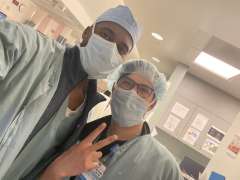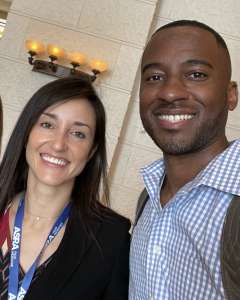Q&A with Regional Anesthesia Service

1. What is the purpose of the Regional Anesthesia Service at Ronald Reagan UCLA Medical Center? How is it different from the pre-existing Acute Pain Service?
Dr. John Patton: The purpose of the Ronald Reagan Regional Anesthesia Service (RAS) is to more effectively and efficiently provide regional anesthesia at both our Ronald Reagan UCLA Medical Center (RRMC) and Westwood Ambulatory Surgery Center (ASC) for surgical patients and other patients with acute pain for which regional anesthesia would be indicated. A Regional Attending is now available weekdays and non-holidays to function as the lead person for regional anesthesia at RRMC and Westwood ASC.
Both the Acute Pain Service (APS) and the RAS fall under the Regional Anesthesia and Acute Pain Medicine (RAAPM) division. They are two arms. The APS is responsible for epidurals and medication management for acute post-surgical patients and acute post-traumatic patients. The RAS is responsible for peripheral nerve blocks at both RRMC and the Westwood ASC. Both services work very closely together, in a collaborative manner, with the goal of ensuring that our patients get the RAAPM care that they need.
Dr. Benjamin Chu: The purpose of the Regional Anesthesia Service (RAS) at Ronald Reagan is to reliably administer peripheral nerve blocks to provide surgical anesthesia for a variety of vascular and orthopedic cases (e.g. AV fistula creation, below-knee amputation, above-knee amputation, wrist/ankle surgeries) and to provide post-operative analgesia with the goal of reducing patients’ need for opioids. The RAS was started to help the existing APS by offloading some procedures (i.e. peripheral nerve blocks)to allow the APS to meet the demands of its primary patient population: thoracic epidural patients and patients with complex/difficult postoperative pain. We believe that this allows for both services—the APS and RAS—to better meet the needs of our patients.
2. What was the impetus for the creation of this separate service? What was needed for its establishment?
Dr. Patton: The APS has been a mainstay at Ronald Reagan for several years. We have one of the strongest thoracic epidural programs in the country. Additionally, there are a number of other services offered to our patients who present with acute pain. That being said, historically, we have had a difficult time delivering regional anesthesia efficiently and effectively under the former APS umbrella because of increasing demand and limited resources.
There have been discussions about creating a RAS for RRMC for a number of years now. During the pandemic, when the world came to a halt, we had time to really reimagine how the APS might evolve to better meet the demands for regional anesthesia at RRMC. The Department of Anesthesiology and Perioperative Medicine (DAPM) leadership, notably our chair Maxime Cannesson, MD, PhD, has been very supportive. We had many meetings, reviewed the literature, sought advice from RAAPM experts around the country, derived a business plan, engaged other stakeholders, and so forth.
Judi Turner, MD, PhD, DAPM Vice Chair for Education, also approached our team, expressing her desire to explore how a dedicated RAS might positively impact the educational needs of our trainees. Our trainees need and desire more opportunities to perform regional blocks and learn from our RAAPM faculty so that they are better equipped for life after training (i.e. for boards and their future practice). The hope is that this service will allow for a more robust educational experience.
Additionally, we recognize that there are potential benefits to the health system as well, in terms of improved throughput of perioperative patients, decreased length of stay in recovery, and decreased costs, to name a few.
3. When did the Division launch the program?
Dr. Patton: The Ronald Reagan Regional Anesthesia Service (RAS) was launched on September 5, 2023.

4. How has the RR Regional Anesthesia Service done so far? What are some wins? What have been the major challenges? Which of these challenges were anticipated, and which were unanticipated?
Dr. Patton: The RAS has by all estimations been a great success thus far. From our discussions with individuals who launched regional services at other academic centers, we know it may take a few years before the program is functioning as a highly productive, well oiled machine. It’s only been four months, and we’ve received a lot of positive feedback from surgeons, anesthesia colleagues, nursing, and other staff.
When we launched, we wanted to be conservative and not take on more than we could handle, so we focused our energy and efforts on surgical services that we had already been working with to improve regional anesthesia delivery for them. Those services include Orthopedics, Podiatry, Vascular Surgery, and Gynecology. Our utilization of regional anesthesia has improved since launching this service, and of note, our outpatient peripheral nerve catheter program has seen an uptick.
We anticipated that there would be challenges, and that we would have ups and downs. Many of the challenges that we have faced really come down to changing culture and operations. This is why it’s very important to ensure that stakeholders are engaged and that there is buy-in from all those who are involved.
Some solutions we have created include leveraging Care Connect or Epic to allow us to perform blocks more efficiently. We are also working on developing enhanced recovery after surgery protocols (ERAS) and clinical pathways that will include regional anesthesia. We have worked with perioperative leadership to expedite regional patients through admissions and the preoperative area. We have created regional block bays in Preop to create a central location to perform our tasks—this has been shown to improve throughput.
Another challenge is that we are currently only functioning with one regional attending at a time. The hope is that in the near future, the RAS will include a resident(s) and regional fellow, and that later down the road as volume increases, we would even have a nurse on the team. The RAS would then be more of a care team. Right now, it is a solo regional faculty member who manages pretty much everything, which on some days can be quite busy.
The good thing is, we are not reinventing the wheel. There are a lot of examples of successful regional programs across the nation, including here at our Santa Monica-UCLA Medical Center & Orthopaedic Hospital, so we have a lot of great examples to draw on.
Dr. Chu: Some of the most gratifying moments/wins from the RAS thus far have been caring for our vascular and orthopedic patients. One of our patients undergoing a below-knee amputation was particularly concerned about postoperative pain given her preoperative pain and prior experiences with postoperative pain. With two peripheral nerve catheters, her pain was very manageable and required minimal opioids. We were able to make her perioperative experience as positive as it could be, given the circumstances.
5. What are the Division's hopes and goals for the service moving forward?
Dr. Patton: My hope is that in the future, regional anesthesia at RRMC will be viewed as a primary option and not a secondary option or merely a rescue analgesic plan. There are a lot of opportunities for this service; it’s a very exciting time. Although we’ve come a long way, we still have a long way to go. Our patients will benefit. Our surgeons will benefit. Our anesthesia colleagues will benefit. Nursing will benefit. We will all benefit from better or increased utilization of regional anesthesia. Our goal is to continue to partner and collaborate with stakeholders so that we can provide the best care that we can for our patients.
Dr. Chu: I have two main hopes/goals for the service moving forward: (1) expanding our reach to be able to serve more patients who would greatly benefit from regional anesthesia (e.g. breast, gynecology, donor nephrectomy cases, to name a few), and (2) to have dedicated/structured involvement of trainees in the service. This service offers the potential to greatly benefit patients, but also offers an exciting and expansive learning opportunity for our trainees that will be invaluable for their growth.
6. Can you share your personal experience(s) with being involved with the service? What has it been like for you personally?

Dr. Patton: For me, after finishing RAAPM fellowship and accepting a faculty position at UCLA, I dreamt of the possibility of expanding regional anesthesia services at RRMC and the Westwood ASC. This was something that was discussed with our department chair and leadership. It truly does take a village. It’s been a phenomenal experience working with other regional faculty to develop this service over the last few years. It’s been a lot of work, frankly, and challenging, but very rewarding at the same time. I’ve learned a lot and have enjoyed working with the DAPM leadership, hospital leadership, our surgeons, nurses, and many others to bring this vision to fruition.
Dr. Chu: As expected with starting any new service, there have been many ups and downs, but my overall experience has been incredibly positive. Seeing and hearing the enthusiasm for the service from our trainees and attendings has been extremely gratifying. Additionally, performing more procedures and seeing the improvements that our trainees are making in their regional anesthesia skills has been extremely rewarding.
7. Which patients are best suited for the Regional Anesthesia Service? How can we contact the Regional Anesthesia Service at Reagan for a consultation?
Dr. Patton: There’s solid evidence that supports the use of regional anesthesia for pain management and/or surgical anesthesia. Many patients can benefit. From trauma, to orthopedics, vascular surgery, cardiac surgery, thoracic surgery, general surgery, obstetrics and gynecology, podiatry—the list goes on. “Multimodal analgesia” have been buzz words for the last decade or so, with the goal to reduce the use of opioids and their associated side effects. Regional anesthesia is just one component of multimodal analgesia and may allow patients to spend less time in the recovery room, require less opioids, and overall have a better perioperative experience.
The best way to contact our service is to page the regional anesthesia pager. Our pager number is 96423. You can also contact the RAS attending for the day directly. We are listed on the daily workforce sheet that is emailed and on QGenda. Lastly, for consult requests, you can place a consult on Care Connect (Consult to Anesthesiology Regional Anesthesia).
Dr. Valeria Carcamo-Cavazos: One could argue that most patients getting moderately to severely painful surgeries could benefit from regional anesthesia if a regional technique is available for that body part; however, regional is still a limited resource. The patients that would benefit the most are those who don't tolerate the use of opioids, which include older patients, patients that have medical problems such as OSA or COPD, chronic pain patients with chronic opioid use and tolerance, and patients with a history of opioid abuse.
Currently, we are offering blocks for the specific surgical services that John mentioned, but we are hoping to expand as we hire more regional attendings to support the RAS.
8. How can we as your colleagues and as the department better support the Regional Anesthesia Service?
Dr. Patton: A big ask for our DAPM colleagues is that we all advocate for regional anesthesia. As perioperative physicians and nurse anesthetists, we have the unique ability to have a great impact on our patients’ perioperative experiences. When preoping our patients, if we believe the case or procedure has a good indication for regional anesthesia, we should advocate for it. The RAS faculty will review the next day’s cases and will reach out to surgeons to express our desire to offer regional anesthesia to their patients. However, in the event that we miss a case or procedure, or if there’s an add-on, it helps to have our colleagues’ invested interest and support. Whether it be reaching out and asking the RAS faculty if we think your case would be a great case for regional anesthesia, or by simply communicating with your surgeon(s) and expressing our desire to include regional anesthesia as part of the anesthetic plan, at the end of the day, it takes a village. The success of this service will depend on all of us.
Dr. Carcamo-Cavazos: Help identify patients who would benefit from regional anesthesia and consent them for it. We can always decide to do a block postop if patients are appropriately consented. Of note, patients should only be consented by an experienced practitioner, not an early CA-1 who hasn't done regional. Of course, we can facilitate all of this as well, but if the RAS is busy elsewhere, this ensures that patients get the procedures they need. We really appreciate your help!